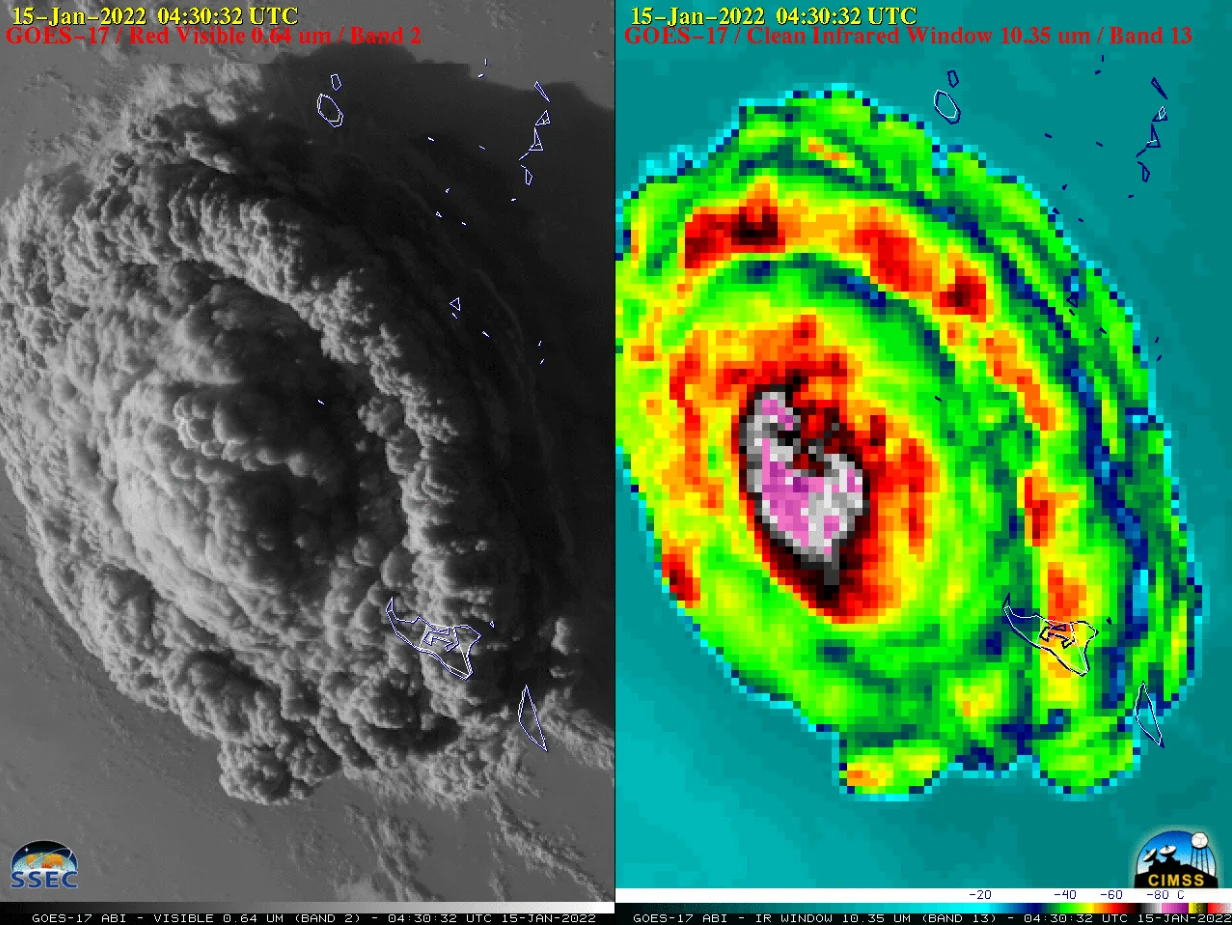
Tonga volcano eruption was so violent it blew ash halfway to space
The cataclysmic eruption of the Pacific’s Hunga Tonga-Hunga Ha’apai volcano was so powerful that it blasted its ash cloud halfway to space.
January’s mammoth eruption of Hunga Tonga-Hunga Ha’apai was so powerful that the underwater Pacific volcano blasted its ash cloud more than 55 km into the atmosphere, making it the tallest such plume ever observed, according to a new study released by researchers with the University of Oxford.
DON’T MISS: Hunga Tonga eruption heard almost 10,000 km away in Canada’s Yukon
Hunga Tonga-Hunga Ha’apai, often referred to as just Hunga Tonga, is a submarine volcano near the nation of Tonga in the southern Pacific Ocean. A group of Oxford researchers discovered that the volcano’s January 15, 2022, eruption vaulted its ash cloud more than five times as high as the most vigorous thunderstorms that tower over tornado alley.
Using satellite data, the team found that the very top of the plume reached a maximum height of 57 km—higher than any ash cloud ever observed.
SEE THE AFTERMATH: Satellites capture Hunga Tonga’s violent eruption
Hunga Tonga’s ash cloud pushed deep into the mesosphere, or the layer of the atmosphere that’s about halfway between Earth’s surface and the edge of space. The mesosphere is where meteors burn up before reaching the ground, and where a returning spacecraft encounters the greatest heat of reentry on its descent from orbit.
The ash plume’s unique height made measuring its ultimate stature a challenge for the researchers. Scientists can use weather satellites to estimate cloud heights based on the temperature of the cloud itself. Generally, higher clouds produce colder cloud tops.
However, that method breaks down once you rise above the troposphere, the layer of the atmosphere closest to the ground. Temperatures fluctuate quite a bit the closer you get to space, with temperature inversions—layers of warmer air above layers of colder air—commonplace in the stratosphere and mesosphere.

A visible and infrared satellite view of the ash cloud produced by the violent eruption of Hunga Tonga-Hunga Ha'apai volcano on January 15, 2022. (NOAA/University of Wisconsin-Madison/CIMSS/SSEC)
These inversions made it too difficult to use cloud top temperatures to estimate the height of Hunga Tonga’s ash cloud. Instead, researchers had to utilize the parallax effect to accurately measure how high the plume grew.
MUST SEE: Tonga volcanic eruption released more energy than most powerful nuclear bomb
The parallax effect is an optical phenomenon in which an object appears to change position depending on the angle at which you view it. Focus on a nearby object, for example, and alternate between closing your right eye and your left eye. You’ll notice that the object appears to shift slightly—that’s the parallax effect.
Researchers utilized three different weather satellites looking at Hunga Tonga’s ash plume from three different angles, taking advantage of the parallax effect to measure the differences between the three angles and accurately determine the plume’s ultimate height.
CHECK IT OUT: Hunga Tonga eruption’s pressure wave circles the Earth
The volcano’s immense eruption on January 15, 2022, produced such a shock that it generated a destructive tsunami across the Pacific, killing several people in Peru and sending a surge of seawater into harbours along the California coast.
Hunga Tonga’s blast sent an air pressure wave circling the globe several times in the following days, an atmospheric ripple that registered on barometers across North America and even created an audible boom as far away as Canada’s Yukon.
One major factor behind the magnitude of the eruption’s violence was likely the fact that it was a steam explosion and volcanic eruption wrapped into one event. Ocean water instantly boiled into steam as the Earth’s crust split open and molten lava belched into the sea, magnifying the force of the explosion.
WATCH: Fallout from volcano in Tonga could be long-lasting
Thumbnail courtesy of the Japan Meteorological Agency










